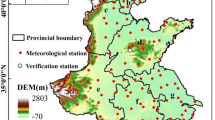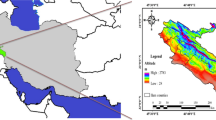Abstract
Drought usually occurs as a result of an imbalance between water supply and demand. Drought indices, an important tool for studying drought, are commonly used for drought monitoring and drought risk assessment. The ground-based drought indices, with high accuracy, are limited in the area monitored. In contrast, the remotely sensed drought index covers a large area but with poor accuracy. Data-driven data fusion–based estimation of ground indices helps to fill this gap. The overall objective is to determine whether various remotely sensed drought factors can effectively monitor drought in arid and semi-arid northern China. In this study, the ground-based drought index SPEI was reconstructed by using remotely sensed drought factors, divided from the Global Precipitation Measuring Mission GPM, GLDAS, and MODIS satellite sensors as well as environmental covariates. Based on climate elements, soil elements, vegetation, and environmental covariate elements, a composite drought index CDIS was established in this study. In this study, the single drought index, multivariate linear integrated drought index, and bias-corrected random forest method were used as the prediction model. Based on ground truth historical climate data as reference data, the performance of the model-predicted composite drought index CDIS in drought monitoring was evaluated. Our results indicate that the drought index on 1-month time scale has no significant advantage over the maximum single drought index. The bias-corrected random forest model with drought index predictions outperformed multiple linear regression and single drought index, with higher prediction accuracy in semi-arid and semi-humid regions than in arid regions. Compared with the ground station drought indices, the drought map based on bias-corrected random forest shows visual and statistical consistency. Under the background of a non-homogeneous and complex surface environment, the model prediction results integrating environmental covariates performed best, and the method used in the study was effective and could be extended and applied. For areas where information is scarce, remote sensing data can be easily extended to regional scale monitoring, which can better achieve high-precision drought monitoring at the regional scale.













Similar content being viewed by others
Data availability
All the datasets are available in the repository of Google Earth Engine (GEE). The links to each, along with their titles, are mentioned below:
MOD09A1.061, Terra Surface Reflectance 8-Day Global 500 m, https://code.earthengine.google.com/.
MOD11A2.061, Terra Land Surface Temperature and Emissivity 8-Day Global 1 km,
https://code.earthengine.google.com/.
MOD13A3.v006, MODIS/Terra Vegetation Indices Monthly L3 Global 1 km SIN Grid,
https://lpdaac.usgs.gov/products/mod13a3v006/.
GLDAS-2.1, Global Land Data Assimilation System, https://code.earthengine.google.com/.
GPM, Global Precipitation Measurement (GPM) v6, https://code.earthengine.google.com/.
MCD12Q1v006, MODIS/Terra + Aqua Land Cover Type Yearly L3 Global 500 m SIN Grid, https://lpdaac.usgs.gov/products/mcd12q1v006/.
Ground in situ climate datasets, http://data.cma.cn/.
Code availability
Not applicable.
Change history
31 January 2023
A Correction to this paper has been published: https://doi.org/10.1007/s00704-023-04379-3
References
AghaKouchak A, Farahmand A, Melton FS, Teixeira J, Anderson MC, Wardlow BD, Hain CR (2015) Remote sensing of drought: progress, challenges and opportunities. Rev Geophys 53(2):452–480
Alam NM, Sharma GC, Moreira E, Jana C, Mishra PK, Sharma NK, Mandal D (2017) Evaluation of drought using SPEI drought class transitions and log-linear models for different agro-ecological regions of India. Phys Chem Earth Part A 100(3):1–43
Alizadeh MR, Nikoo MR (2018) A fusion-based methodology for meteorological drought estimation using remote sensing data. Remote Sens Environ 211:229–247
Bravo RZB, Cunha AP, Leiras A, Cyrino Oliveira FL (2021) A new approach for a drought composite index. Nat Hazards 108(1):755–773
Brewer MJ, Richard R, Will P, Juergen V, Justin S (2011) The global drought monitor portal-the foundation for a global drought early warning system
Citakoglu H, Coşkun Ö (2022) Comparison of hybrid machine learning methods for the prediction of short-term meteorological droughts of Sakarya Meteorological Station in Turkey. Environ Sci Pollut Res 29:75487–75511
Cook BI, Smerdon JE, Seager R, Coats S (2014) Global warming and 21st century drying. Clim Dyn 43(9–10):2607–2627
Dai A, Zhao T (2017) Uncertainties in historical changes and future projections of drought. Part I: estimates of historical drought changes. Clim Change 144(3):519–533
Du L, Tian Q, Yu T, Meng Q, Jancso T, Udvardy P, Huang Y (2013) A comprehensive drought monitoring method integrating MODIS and TRMM data. Int J Appl Earth Obs Geoinf 23:245–253
Feng P, Wang B, Liu DL, Yu Q (2019) Machine Learning-Based Integration of Remotely-Sensed Drought Factors Can Improve the Estimation of Agricultural Drought in South-Eastern Australia. Agric Sys 173:303–316
Genuer R, Poggi JM, Tuleau-Malot C (2015) VSURF: An R package for variable selection using random forests. RJ 7:19–33
Ghasemi P, Karbasi M, Nouri AZ, Tabrizi MS, Azamathulla HM (2021) Application of Gaussian process regression to forecast multi-step ahead SPEI drought index. AEJ 60:5375–5392
Gremer JR, Bradford JB, Munson SM, Duniway MC (2015) Desert grassland responses to climate and soil moisture suggest divergent vulnerabilities across the southwestern United States. Glob Change Biol 21:4049–4062
Heim RR (2002) A Review of Twentieth-Century Drought Indices Used in the United States. Bull Am Meteorol Soc 83(8):1149
Huang J, Li Y, Fu C, Chen F, Fu Q, Dai A, Shinoda M, Ma Z, Guo W, Li Z, Zhang L, Liu Y, Yu H, He Y, Xie Y, Guan X, Ji M, Lin L, Wang S, Yan H, Wang G (2017) Dryland climate change: recent progress and challenges. Rev Geophys 55(3):719–778
Ji L, Peters AJ (2003) Assessing vegetation response to drought in the northern Great Plains using vegetation and drought indices. Remote Sens Environ 87(1):85–98
Kogan FN (1997) Global drought watch from space. Bull Am Meteorol Soc 78(4):621–636
Liu QI, Zhang S, Zhang H, Bai Y, Zhang J (2020) Monitoring drought using composite drought indices based on remote sensing. Sci Total Environ 711:134585
Ma S, Zhang S, Wu Q, Wang J (2020) Long-term changes in surface soil moisture based on CCI SM in Yunnan Province, Southwestern China. J Hydrol 588:125083
Mathbout S, Lopez-Bustins JA, Royé D, Martin-Vide J (2021) Mediterranean-scale drought: regional datasets for exceptional meteorological drought events during 1975–2019. Atmosphere 12(8):941
McKee TB, Doesken NJ, Kleist J (1993) The relationship of drought frequency and duration to time scales. Eighth conference on applied climatogy. American meteorological society, Anaheim, CA
Palmer WC, Havens AV (1958) A graphical technique for determining evapotranspiration by the thornthwaite method. Mon Weather Rev 86:123–128
Pan N, Wang S, Liu Y, Hua T, Zhang J, Xue F, Fu B (2021) Quantifying responses of net primary productivity to agricultural expansion in drylands. Land Degrad Dev 32(5):2050–2060
Park S, Im J, Jang E, Rhee J (2016) Drought assessment and monitoring through blending of multi-sensor indices using machine learning approaches for different climate regions. Agric Meteorol 216:157–169
Poornima S, Pushpalatha M (2019) Drought prediction based on SPI and SPEI with varying timescales using LSTM recurrent neural network. Soft Comput 23:8399–8412
Prodhan FA, Zhang J, Yao F, Shi L, Pangali Sharma TP, Zhang D, Cao D, Zheng M, Ahmed N, Mohana HP (2021) Deep learning for monitoring agricultural drought in South Asia using remote sensing data. Remote Sens 13(9):1715
Rhee J, Im J, Carbone GJ (2010) Monitoring agricultural drought for arid and humid regions using multi-sensor remote sensing data. Remote Sens Environ 114(12):2875–2887
Shah D, Mishra V (2020) Integrated drought index (IDI) for drought monitoring and assessment in India. Water Resour Res 56(2):e2019WR026284
Sheffield J, Wood EF, Roderick ML (2012) Little change in global drought over the past 60 years. Nature 491(7424):435–438
Shi N, Chen L (2004) Evolution and features of global land June–August dry/wet periods during 1920–2000. Int J Climatol 24(12):1483–1493
Song J (2015) Bias corrections for random forest in regression using residual rotation. J Korean Stat Soc 44(2):321–326
Thornthwaite CW (1948) An approach toward a rational classification of climate. Geogr Rev 38:55
Trnka M, Hlavinka P, Možný M, Semerádová D, Štěpánek P, Balek J, Bartošová L, Zahradníček P, Bláhová M, Skalák P, Farda A, Hayes M, Svoboda M, Wagner W, Eitzinger J, Fischer M, Žalud Z (2020) Czech Drought Monitor System for monitoring and forecasting agricultural drought and drought impacts. Int J Climatol 40(14):5941–5958
Vicente-Serrano SM, Beguería S, López-Moreno JI (2010) A multiscalar drought index sensitive to global warming the standardized precipitation evapotranspiration index. J Clim 23(7):1696–1718
Wei W, Zhang J, Zhou L, Zhou L, Xie BB, Zhou JJ, Li CH (2021) Comparative evaluation of drought indices for monitoring drought based on remote sensing data. Environ Sci Pollut Res 28:20408–20425
Zhang A, Jia G (2013) Monitoring meteorological drought in semiarid regions using multi-sensor microwave remote sensing data. Remote Sens Environ 134:12–23
Zhang G, Lu Y (2012) Bias-corrected random forests in regression. J Appl Stat 39(1):151–160
Zhang L, Jiao W, Zhang H, Huang C, Tong Q (2017) Studying drought phenomena in the continental United States in 2011 and 2012 using various drought indices. Remote Sens Environ 190:96–106
Zhang L, Liu Y, Ren L, Jiang S, Yang X, Yuan F, Wang M, Wei L (2019) Drought monitoring and evaluation by ESA CCI soil moisture products over the yellow river basin. IEEE J-STARS 12(9):3376–3386
Zhang X, Li M, Ma Z, Yang Q, Lv M, Clark R (2019) Assessment of an evapotranspiration deficit drought index in relation to impacts on ecosystems. Adv Atmos Sci 36(11):1273–1287
Zhang Y, Huang S, Huang Q, Leng G, Wang H, Wang L (2019) Assessment of drought evolution characteristics based on a nonparametric and trivariate integrated drought index. J Hydrol 579:124230
Zhang Q, Cui N, Zhao L, Xu Y, Li Q, Liu F (2020) Seasonal drought characteristics based on relativemoisture index in Yunnan Province. Agric Res Arid Areas 38(4):278–284
Zhao H, Gao G, An W, Zou X, Li H, Hou M (2017) Timescale differences between sc-PDSI and SPEI for drought monitoring in China. Phys Chem Earth Parts a/b/c 102:48–58
Funding
This research was funded by the key Project of Natural Science Foundation of Xinjiang Uygur Autonomous Region (No. 2021D01D06) and the National Natural Science Foundation of China (No. 41961059).
Author information
Authors and Affiliations
Contributions
Conceptualization, Junyong Zhang and Jianli Ding; writing—review, editing, and formal analysis, Junyong Zhang; writing—original draft preparation, Junyong Zhang; visualization, Junyong Zhang.; project administration, Junyong Zhang; meteorological datasets, Jinjie Wang; language modification, Hua Lin; statistical software, Lijing Han; pre-processing of images, Xiaohang L; acquiring images, Jie Liu.
Corresponding author
Ethics declarations
Ethics approval
Ethics have been vetted, and there is no ethical or moral conflict.
Consent to participate
All authors agree to sign and participate in the submission.
Consent for publication
All authors agree to publish.
Competing interests
The authors declare no competing interests.
Additional information
Publisher's note
Springer Nature remains neutral with regard to jurisdictional claims in published maps and institutional affiliations.
The original online version of this article was revised: Fig. 13 is wrong due to an oversight.
Rights and permissions
Springer Nature or its licensor (e.g. a society or other partner) holds exclusive rights to this article under a publishing agreement with the author(s) or other rightsholder(s); author self-archiving of the accepted manuscript version of this article is solely governed by the terms of such publishing agreement and applicable law.
About this article
Cite this article
Zhang, J., Ding, J., Wang, J. et al. Remote sensing drought factor integration based on machine learning can improve the estimation of drought in arid and semi-arid regions. Theor Appl Climatol 151, 1753–1770 (2023). https://doi.org/10.1007/s00704-022-04305-z
Received:
Accepted:
Published:
Issue Date:
DOI: https://doi.org/10.1007/s00704-022-04305-z




